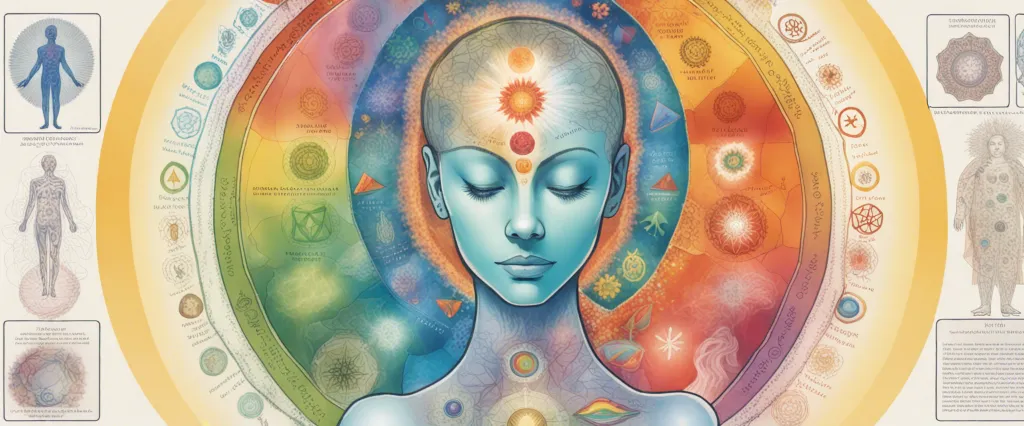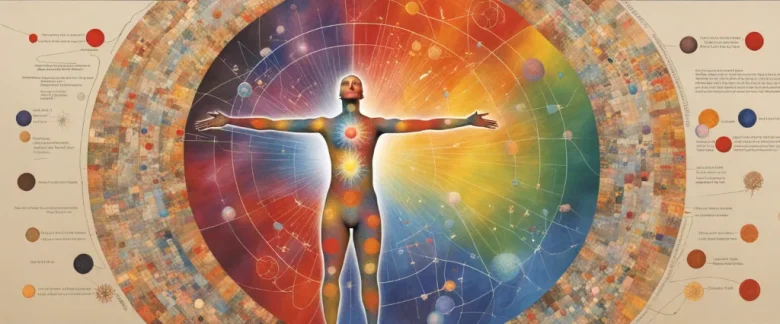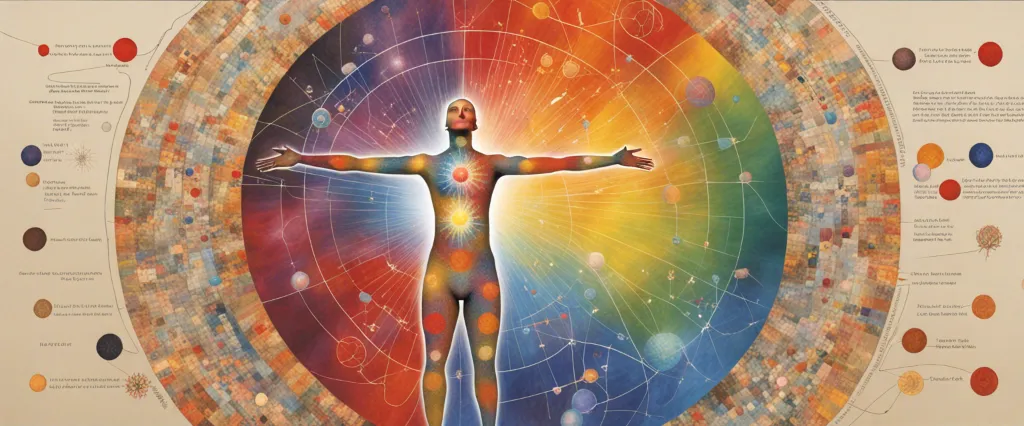In her groundbreaking book, “Anatomy of the Spirit,” Caroline Myss reveals the profound connection between our psychological and physical well-being. Drawing on her extensive background as a medical intuitive and renowned holistic healer, Myss explores the seven energy centers of the body, also known as chakras, to unlock the secrets of human consciousness and spiritual growth. By diving deep into these energy centers, Myss sheds light on the powerful role they play in our overall health, providing invaluable insights for individuals seeking to restore balance and harmony in their lives. With her unique blend of medical expertise and spiritual wisdom, Myss offers practical guidance that empowers us to embark on a transformative journey towards self-healing and personal empowerment.
Chapter 1: The Seven Energy Centers – Introducing the concept of the seven energy centers, also known as chakras, and exploring their significance in our physical, emotional, and spiritual well-being.
In Chapter 1 of “Anatomy of the Spirit” by Caroline Myss, the author introduces the concept of the seven energy centers or chakras. Myss explains that these energy centers, which are located along the spine from the base to the crown of the head, play a crucial role in our physical, emotional, and spiritual well-being.
The seven chakras are associated with specific physical organs and systems, as well as with various aspects of our emotional and psychological states. Myss explores the significance of each energy center in detail. For instance, the first chakra, located at the base of the spine, is associated with survival, security, and basic instincts. The second chakra, located in the pelvic area, is connected to creativity, sexuality, and personal power.
Moving up the spine, each chakra represents different aspects of our being. The third chakra relates to personal will and power, while the fourth chakra, located at the heart, represents love, compassion, and forgiveness. The fifth chakra, located in the throat, concerns communication and self-expression. The sixth chakra, or the third eye, is associated with intuition and inner vision, while the seventh chakra, at the crown of the head, represents our connection to the divine.
Myss emphasizes the importance of maintaining balance and alignment in these energy centers for optimal health and well-being. When any of these chakras are stagnant or blocked, it can result in physical ailments, emotional disturbances, and spiritual disconnection. By understanding and working with these energy centers, individuals can heal and transform their lives.
In summary, Chapter 1 of “Anatomy of the Spirit” introduces the concept of the seven energy centers or chakras, discussing their significance in our physical, emotional, and spiritual well-being. The chapter provides an overview of each chakra’s association with specific aspects of our being and emphasizes the importance of maintaining balance to achieve optimal health and wholeness.
Chapter 2: The Power of Belief – Examining the profound impact of our beliefs on our health and life experiences, and how they can either support or hinder our spiritual growth.
Chapter 2 of “Anatomy of the Spirit” by Caroline Myss delves into the significance of our beliefs and their profound influence on our health, life experiences, and spiritual growth. Myss emphasizes that our beliefs not only shape our worldview but also directly impact our well-being.
The chapter begins by explaining that our beliefs are deeply ingrained and often inherited, stemming from cultural, religious, and societal influences. She highlights that these beliefs shape our perceptions and lay the foundation for our experiences. Beliefs, Myss argues, are energetic patterns that either support or hinder our spiritual journey.
Myss explores the concept of holistic medicine, which acknowledges that the mind, body, and spirit are interconnected. She suggests that our beliefs can strongly influence our physical health, explaining that illnesses can often be traced back to deep-seated emotional or spiritual imbalances. On the other hand, she notes that shifting our beliefs and cultivating positive thoughts can lead to healing and restoration.
Furthermore, Myss emphasizes the importance of taking responsibility for our beliefs. She advises against clinging to victim mentalities and encourages readers to recognize their power in shaping their reality. By consciously examining and challenging our beliefs, we can discard limiting notions and open ourselves up to growth and transformation.
In conclusion, Chapter 2 of “Anatomy of the Spirit” highlights the immense power of our beliefs. It emphasizes the profound impact they have on our health and experiences, while also emphasizing the potential for spiritual growth. Myss encourages readers to examine and modify their beliefs, empowering them to take control of their lives and embrace a higher level of consciousness.
Chapter 3: Healing the Wounds of the Past – Exploring the connection between our emotional wounds and the energy blocks in our energy centers, and providing insights on how to heal and release these wounds.
In Chapter 3 of “Anatomy of the Spirit” by Caroline Myss, titled “Healing the Wounds of the Past,” the author delves into the relationship between our emotional wounds and the energy blocks that manifest within our energy centers or chakras. Myss guides readers in understanding how our past traumas or wounds can impact our physical, emotional, and spiritual well-being.
The chapter highlights the concept that unresolved emotional issues can lead to energy blockages within the body’s seven main energy centers. Myss explains that each energy center corresponds to a specific aspect of our lives, such as our relationships, self-expression, or sense of purpose. These blockages hinder the flow of energy and can result in physical or emotional ailments.
Myss emphasizes the importance of acknowledging and releasing these wounds in order to restore balance and healing. She suggests that introspection and self-reflection are powerful tools to begin this healing process. By unraveling the root causes of our emotional wounds and gaining insight into their origin, we can gradually heal and release these blockages.
The chapter provides practical insights for healing and transforming past wounds. Myss suggests that forgiveness, both of self and others, plays a crucial role in releasing these energy blocks. Furthermore, she encourages embracing the lessons learned from these wounds and integrating them into our personal growth.
In summary, Chapter 3 of “Anatomy of the Spirit” delves into the connection between emotional wounds and energy blocks within the body’s energy centers. By exploring the root causes of these wounds and following a path of forgiveness and self-reflection, individuals can heal and release these blockages, ultimately restoring balance and well-being in their lives.
Chapter 4: Sacred Contracts – Discussing the concept of sacred contracts, the agreements we make before birth to learn specific life lessons, and how they shape our spiritual journey.

Chapter 4: Sacred Contracts of the book Anatomy of the Spirit by Caroline Myss explores the concept of sacred contracts and their significance in shaping our spiritual journey. Myss proposes that before we are born, our souls make agreements known as sacred contracts to learn specific life lessons and fulfill our higher purpose.
According to Myss, sacred contracts are agreements we make with divine forces, ancestors, and other beings before entering this physical realm. These contracts consist of our intended life lessons, spiritual challenges, and opportunities for growth. They are designed to guide us towards self-awareness, empowerment, and achieving our soul’s purpose.
Myss emphasizes that identifying and honoring our sacred contracts is crucial for personal growth and inner harmony. To discover our contracts, she suggests examining the patterns and themes that recur in our lives, as they often reflect our life lessons. These patterns can be identified by examining our relationships, career choices, and personal challenges.
The author further emphasizes that understanding our sacred contracts requires a deep level of self-reflection and trust in our intuition. By acknowledging and embracing these contracts, we gain a sense of purpose and the ability to navigate life’s challenges with grace and resilience.
Myss also highlights that sacred contracts can evolve and change throughout our lives. As we grow and develop, we may renegotiate or fulfill existing contracts and make new agreements to facilitate our spiritual growth. By consciously engaging with our sacred contracts, we are able to live a more authentic and fulfilling life, aligned with our higher purpose.
In summary, Chapter 4 explores the concept of sacred contracts and their role in shaping our spiritual journey. Myss emphasizes the importance of identifying and honoring these contracts to gain self-awareness, navigate challenges, and fulfill our soul’s purpose. Understanding and embracing our sacred contracts allows us to live a more meaningful and purposeful life.
Chapter 5: Archetypes and Personal Power – Exploring the role of archetypes in our lives and how understanding them can help us reclaim our personal power and live authentically.
Chapter 5 of “Anatomy of the Spirit” by Caroline Myss explores the concept of archetypes and how understanding them can aid in reclaiming personal power and living authentically. Myss suggests that archetypes are universal patterns of behavior and symbols deeply ingrained in the collective unconscious, influencing our thoughts, choices, and actions.
The chapter begins by emphasizing the need to be aware of the archetypes that govern our lives, as they shape our identities and experiences. Myss explains that certain archetypes, such as the Child or the Prostitute, can hinder personal growth, while others, like the Warrior or the Sage, can empower individuals. Identifying these archetypal patterns allows us to become conscious of how they influence our lives and to consciously choose which ones to embody.
Myss illustrates how different archetypes manifest in our daily lives through various examples and stories. She emphasizes the importance of recognizing when we are playing out archetypal roles unconsciously, and how this can lead to feeling disempowered or trapped. By understanding the archetypes we engage with and creating a conscious relationship with them, we can regain control over our lives and make choices that align with our authentic selves.
Moreover, Myss explains that archetypes act as a framework for personal growth and transformation. By recognizing and working with archetypal energies, we can access our full potential and tap into our personal power. She stresses the significance of aligning our actions, beliefs, and values with the archetypes that resonate with our true selves.
In summary, Chapter 5 of “Anatomy of the Spirit” delves into the role of archetypes in our lives. Myss emphasizes the importance of understanding these archetypal patterns, recognizing when we embody them unconsciously, and consciously choosing which ones to embody in order to reclaim personal power and live authentically.
Chapter 6: Intuition and Divine Guidance – Discussing the importance of developing and trusting our intuition as a means of receiving divine guidance and navigating our spiritual path.
In Chapter 6 of “Anatomy of the Spirit” by Caroline Myss, the author explores the significance of intuition and divine guidance in our spiritual journey. Myss emphasizes the importance of developing and trusting our intuition as a powerful tool for receiving guidance from the divine.
According to Myss, intuition acts as a direct line of communication with the divine source, allowing us to tap into the wisdom and guidance that is always available to us. She suggests that intuition is a natural sense that can be cultivated and strengthened through practice.
Myss also discusses how our intuition can help us navigate our spiritual path. By listening to our inner voice and following our gut feelings, we can make decisions in alignment with our true purpose and higher self. She explains that divine guidance often comes in the form of intuitive nudges, synchronicities, or a deep knowingness that cannot be explained by logical reasoning alone.
Trusting our intuition is essential, as it allows us to connect with the divine and receive guidance beyond our limited human understanding. Myss warns against dismissing intuitive messages or allowing fear and doubt to cloud our judgment. Instead, she encourages us to develop a relationship with our intuition by honoring and acting upon its guidance.
In conclusion, Chapter 6 of “Anatomy of the Spirit” delves into the significance of intuition and divine guidance in our spiritual growth. Myss emphasizes the development and trust in our intuition as a means of receiving divine guidance, making decisions aligned with our true purpose, and navigating our spiritual path effectively.
Chapter 7: The Power of Forgiveness – Examining the transformative power of forgiveness in releasing negative energy and healing our relationships, both with others and ourselves.
Chapter 7 of the book “Anatomy of the Spirit” by Caroline Myss explores the profound impact of forgiveness on our overall well-being and the healing of our relationships. Myss reveals how forgiveness has the power to release negative energy and promote transformation within ourselves and our connections with others.
The chapter commences by emphasizing that harboring resentment and holding onto grudges only serves to drain our energy and inhibit our spiritual growth. Myss highlights the importance of forgiving ourselves and others for past wrongdoings as a means to break free from the emotional chains that keep us stagnant and stuck.
Moreover, Myss explains that forgiveness is not a one-time act but a lifelong process, as we may need to continually forgive those who have hurt us. She explores the three levels of forgiveness – forgiving others, self-forgiveness, and asking for forgiveness – and delves into the psychological and emotional effects of each level. Myss also emphasizes that forgiving does not imply condoning the actions of others, but rather freeing ourselves from the burden of resentment and anger.
Additionally, the chapter delves into the concept of forgiving oneself and the powerful release it can bring. Myss acknowledges that self-forgiveness can be incredibly challenging, as we often carry shame and guilt for our own perceived shortcomings. However, she highlights the necessity of embracing self-forgiveness in order to transcend past mistakes and move towards personal growth.
Overall, Chapter 7 of “Anatomy of the Spirit” illustrates the transformative power of forgiveness in healing relationships and releasing negative energy. By letting go of resentment, cultivating forgiveness, and embracing self-forgiveness, individuals can experience profound shifts in their spiritual, emotional, and physical well-being.

Chapter 8: The Path to Divine Connection – Exploring practices and techniques for deepening our connection with the divine and aligning our energy centers to experience spiritual wholeness and enlightenment.
Chapter 8 of “Anatomy of the Spirit” by Caroline Myss explores practices and techniques that can help individuals deepen their connection with the divine and align their energy centers to experience spiritual wholeness and enlightenment.
Myss begins the chapter by emphasizing the importance of divine connection in one’s spiritual journey. She states that accessing divine guidance and understanding our spiritual purpose requires a conscious commitment to cultivating a relationship with the divine. The chapter explores different practices that can aid in this process.
The first practice discussed is prayer. Myss explains that prayer is not merely a petition for the divine to fulfill our desires but an opportunity to surrender to a higher power and open ourselves to divine wisdom and guidance. She also encourages individuals to cultivate a daily prayer practice to strengthen their connection with the divine.
Another practice explored is meditation. Myss explains that meditation allows individuals to quiet their minds and ego-driven thoughts, creating a space for divine consciousness to flow through them. She offers various techniques for meditation, including breathwork and visualization exercises.
In addition to prayer and meditation, Myss introduces the concept of energy centers or chakras. She explains that aligning these centers enables individuals to create a harmonious flow of energy in their bodies, facilitating spiritual growth and awakening. Myss provides insights into each energy center, its associated qualities, and techniques to balance and activate them.
Overall, Chapter 8 of “Anatomy of the Spirit” provides a comprehensive exploration of practices and techniques for deepening one’s connection with the divine and aligning their energy centers. Myss emphasizes the significance of these practices in spiritual wholeness and enlightenment, encouraging readers to embark on a conscious journey of divine connection.
After Reading
In conclusion, Caroline Myss’s book Anatomy of the Spirit offers a profound exploration of the connections between the physical body, emotions, and spiritual well-being. In this comprehensive guide, Myss combines her intuitive insights with scientific and historical perspectives to provide readers with a roadmap to holistic healing and personal growth. By examining the seven energy centers, or chakras, Myss emphasizes the importance of understanding and addressing the spiritual aspects of our lives in order to achieve optimal health and inner harmony. With its blend of wisdom, practical exercises, and inspiring anecdotes, Anatomy of the Spirit serves as a valuable resource for anyone seeking to deepen their understanding of the mind-body-spirit connection and take control of their own healing journey.
1. The Power of Now” by Eckhart Tolle – This transformative book explores the concept of living in the present moment and embracing mindfulness as a means of achieving spiritual enlightenment. It offers practical guidance on how to let go of past grievances and future anxieties, ultimately leading to a more fulfilling and connected life.
2. “The Seat of the Soul” by Gary Zukav – Similar to “Anatomy of the Spirit,” this book delves into the intersection of psychology and spirituality. It explores the concept of the soul and the role it plays in shaping our experiences, relationships, and personal growth. Zukav emphasizes the importance of aligning our intentions with the intentions of the soul in order to live authentically and find true meaning in life.
3. “Molecules of Emotion” by Candace Pert – This captivating book by neuroscientist Candace Pert explores the powerful connection between the mind and the body. Pert explains how our emotions are closely tied to the chemical messaging system of the body, providing insights into the mind-body connection and its impact on our overall well-being. It offers a unique perspective on healing, emphasizing the role of emotions in achieving physical and emotional balance.
4. “The Wisdom of the Enneagram” by Don Richard Riso and Russ Hudson – For readers interested in self-discovery and personal growth, this book delves into the Enneagram, a fascinating personality typing system. It explores the nine different personality types and their underlying motivations, providing valuable insights into our own behaviors and those of others. This book offers practical tools for self-awareness and personal transformation.
5. “The Empath’s Survival Guide” by Judith Orloff – In this book, psychiatrist and empath Judith Orloff offers guidance for highly sensitive individuals who often struggle with emotional overwhelm and energy drain. It outlines actionable strategies to protect one’s energy, manage boundaries, and navigate relationships. Much like “Anatomy of the Spirit,” this book explores how energetic and emotional connections impact our well-being, providing practical tools for empathic individuals to thrive.




